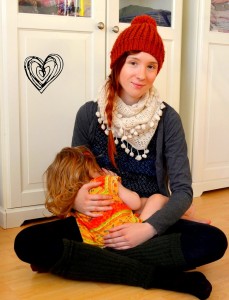Breastfeeding Tips
At the beginning of a feeding make sure that you and the baby are both relaxed and comfortable. The first few feedings may take place in bed; and if it is difficult to sit upright because of a sore perineum, it is possible to feed lying down.
This position is also excellent after a caesarean section. Once mobile. Try to find a chair with a firm back and which is low enough for you to rest your feet flat on the floor, and cradle the baby in your arms. Failing this, sit on the edge of the bed with your feet on a chair.
You may find that it helps to place the baby on a pillow at first so that you don’t have to support his whole weight.

Once you have learned to breast-feed you can discard the pillow.
Once you are both settled comfortably move the baby toward you holding his head in one hand or in the crook of your arm. Hold the baby so that his mouth is in line with the nipple.
Then move the baby toward you holding him so that his head is tipped back slightly and his bottom lip is nearest to the nipple and below it. Lean forward slightly while putting the baby to the breast.
The baby opens his mouth when his lips touch the nipple, so tease him with the nipple until his mouth is wide open before putting him on the breast. Aim his bottom lip at the bottom of the areola and his top lip will be in the right position to take the breast.
Remember that the baby is mobile. So put the baby to the breast rather than the breast to the baby. If the nipple hurts this may be a sign that the baby is not in the right positions because the nipple should be so far back in the mouth that there is no friction on it.
One of the first signs that things are going well is that after a few sucks, which initiate the let-down reflex, the baby falls into the typical rhythm of breast-feeding. This consist of long, deep sucks interspersed with rests during which he remains attached to the breast.
His body is relaxed, but when sucking his ears wriggle, his scalp moves and his cheeks remain full. (If the baby’s cheeks are drawn in this means that there is not a good vacuum between his mouth and the breast.)
After the first short period on the breast the baby will often want to come off and rest. This is because the let-down reflex of the milk is often too much at the beginning of the feeding.
The baby swallows air to keep up and may need to burp at this stage. If babies are burped at this stage it is often not necessary to burp them after the feeding, as the flow of milk steadies after the initial rush. Sit the baby up on your lap and rub his back so that he burps and brings up the air.
The baby will then want to go back to the breast. He will stop of his own accord and then he may or may not want the second breast. This is a good time to change a diaper.
As many babies have a bowel movement while on the first breast, and fall asleep on the second one, this timing has many advantages.
